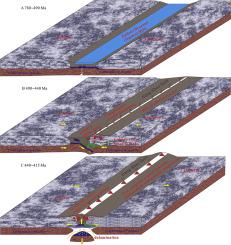Our official English website, www.x-mol.net, welcomes your
feedback! (Note: you will need to create a separate account there.)
Major lithologies of the high-grade Zhoutan terrane within the Cathaysia Block and their tectonic implications for the Neoproterozoic - Paleozoic South China
Lithos ( IF 2.9 ) Pub Date : 2020-11-01 , DOI: 10.1016/j.lithos.2020.105664 Lei Zhao , Ru-cheng Zhang , Ming-Guo Zhai , Xi-Wen Zhou
Lithos ( IF 2.9 ) Pub Date : 2020-11-01 , DOI: 10.1016/j.lithos.2020.105664 Lei Zhao , Ru-cheng Zhang , Ming-Guo Zhai , Xi-Wen Zhou

|
Abstract Pre-Devonian crystalline basement of the Cathaysia Block was united through the Wuyi-Yunkai orogeny. The uplifted orogenic core is dominantly composed of Paleozoic high-grade terranes occurring in a northeast-southwest trending belt. The Zhoutan terrane in the middle part of this belt is one of the key terranes to reveal the tectonic architecture of the South China Block. However, how to correlate it with other high-grade terranes, what kind of rock records are preserved in this terrane and their tectonic implications for the Wuyi-Yunkai orogen are still unresolved. This paper carries out an integrated study on the petrology, zircon U--Pb geochronology, geochemistry and zircon Lu--Hf isotopic compositions of the main rock types in the Zhoutan terrane, with a purpose of better understanding the Wuyi-Yunkai orogeny. Mafic granulite (noritic) of high-T and low-P conditions occurs as lenses within the Zhoutan Formation. The zircon U--Pb geochronological data give magmatic and metamorphic ages of 460–450 Ma and ~ 430 Ma, respectively. Neoproterozoic and Paleoproterozoic (1.89 Ga) xenocrysts also occur. Meta-pelites of the Zhoutan Formation experienced high T/P amphibolite facies metamorphism, and ages of their detrital zircons are dominantly Neoproterozoic (810–820 Ma) with some subordinate Paleo- to Mesoproterozoic and Archean signatures. Amphibole gneiss layers of this formation give a Paleozoic metamorphic age of ~450 Ma, consistent with the high-P amphibolite facies metamorphism of the neighboring Longyou terrane. Fine-grained garnet mica-schist of the Wanyuan Formation consists of greenschist to amphibolite facies mineral assemblage and detrital zircons of these meta-sediments display both Neoproterozoic and early Precambrian ages at ~770 Ma, ~820 Ma, ~850 Ma, ~1.84 Ga and 2.48 Ga. Metamorphosed calc-silicates of the Wanyuan Formation show similar detrital zircon age peaks of 624 Ma, 780–790 Ma, ~810 Ma, 840–850 Ma, 1.8–1.98 Ga and ~ 2.48 Ga, and a Paleozoic metamorphic age of ~447 Ma. The Cizhu pluton is a composite granitoid body intruding the Zhoutan and Wanyuan formations, with emplacement ages ranging at least from 485 Ma to 446 Ma. eHf(t) values of zircons from the mafic granulite range from −10.9 to +8.5, indicating its protolith derived from enriched mantle sources with or without crustal contaminations. The Cizhu magmatic event is a crustal reworking event as indicated by the coherently negative zircon eHf(t) values and ancient Hf crustal model ages of 1530–1830 Ma. Zircon eHf(t) values of the metamorphosed calc-silicates show large variations, ranging from −21.2 to +11, consistent with its complex provenances. The deposition of the sedimentary rocks of the Zhoutan and Wanyuan formations is consistent with the development of the Neoproterozoic-Paleozoic Nanhua Rift. The development of continental margin sequences like the Zhoutan and Wanyuan formations, the evolution of the Paleozoic metamorphism from early higher P/T metamorphic stage to later lower P/T stage, as well as the generation of the Paleozoic mafic-ultramafic rocks and the intermediate Cizhu pluton, are best explained by collision to post-collision settings. We, therefore, conclude that the Zhuotan terrane (as well as other high-grade terranes) witnessed a whole geological cycle, from early rifting to the closure of a rifted basin (Nanhua Basin), and the final lithospheric delamination following the rejoining of continental blocks flanking the rift.
中文翻译:

华夏地块高品位周滩地体主要岩性及其对华南新元古代—古生界的构造意义
摘要 华夏地块前泥盆世结晶基底通过武夷-云开造山作用统一。隆起的造山核主要由分布于东北—西南走向带的古生代高品位地体组成。该带中部的周滩地体是揭示华南地块构造构造的关键地体之一。然而,如何将其与其他高品位地体联系起来,该地体中保存了什么样的岩石记录,以及它们对武夷-云开造山带的构造意义等问题,目前尚无定论。本文对周滩地体主要岩石类型的岩石学、锆石U--Pb年代学、地球化学和锆石Lu--Hf同位素组成进行综合研究,以期更好地认识武夷-云开造山带。高 T 和低 P 条件的镁铁质麻粒岩(诺丽晶)在周滩组内以透镜形式出现。锆石 U--Pb 年代学数据分别给出了 460-450 Ma 和~430 Ma 的岩浆和变质年龄。也出现新元古代和古元古代 (1.89 Ga) 异晶。周滩组变质泥岩经历了高 T/P 角闪岩相变质作用,碎屑锆石年龄以新元古代(810-820 Ma)为主,具有一些次要的古至中元古代和太古代特征。该地层的角闪石片麻岩层给出了~450 Ma的古生代变质年龄,与邻近龙游地体的高P角闪岩相变质作用一致。万源组细粒石榴石云母片岩由绿片岩至角闪岩相矿物组合组成,这些变质沉积物的碎屑锆石在~770 Ma、~820 Ma、~850 Ma、~1.84 Ga显示新元古代和早前寒武纪时代和 2.48 Ga。万源组变质钙硅酸盐显示出类似的碎屑锆石年龄峰值,分别为 624 Ma、780-790 Ma、~810 Ma、840-850 Ma、1.8-1.98 Ga 和~2.48 Ga,以及古生代变质时代约 447 毫安。慈竹岩体是侵入周滩组和万源组的复合花岗岩体,侵位年龄至少为485~446 Ma。来自镁铁质麻粒岩的锆石的 eHf(t) 值范围从 -10.9 到 +8.5,表明其原岩来自富集地幔源,有或没有地壳污染。慈竹岩浆事件是一个地壳改造事件,由相干的负锆石 eHf(t) 值和 1530-1830 Ma 的古 Hf 地壳模型年龄表明。变质的钙硅酸盐的锆石 eHf(t) 值显示出很大的变化,范围从 -21.2 到 +11,与其复杂的来源一致。周滩组和万源组沉积岩的沉积与新元古代—古生界南华裂谷的发育相一致。周滩组、万源组等大陆边缘层序的发育,古生代变质作用由早期高P/T变质阶段向晚期低P/T阶段演化,以及古生代基性-超镁铁质岩和中Cizhu pluton,最好通过碰撞到碰撞后设置来解释。因此,我们
更新日期:2020-11-01
中文翻译:

华夏地块高品位周滩地体主要岩性及其对华南新元古代—古生界的构造意义
摘要 华夏地块前泥盆世结晶基底通过武夷-云开造山作用统一。隆起的造山核主要由分布于东北—西南走向带的古生代高品位地体组成。该带中部的周滩地体是揭示华南地块构造构造的关键地体之一。然而,如何将其与其他高品位地体联系起来,该地体中保存了什么样的岩石记录,以及它们对武夷-云开造山带的构造意义等问题,目前尚无定论。本文对周滩地体主要岩石类型的岩石学、锆石U--Pb年代学、地球化学和锆石Lu--Hf同位素组成进行综合研究,以期更好地认识武夷-云开造山带。高 T 和低 P 条件的镁铁质麻粒岩(诺丽晶)在周滩组内以透镜形式出现。锆石 U--Pb 年代学数据分别给出了 460-450 Ma 和~430 Ma 的岩浆和变质年龄。也出现新元古代和古元古代 (1.89 Ga) 异晶。周滩组变质泥岩经历了高 T/P 角闪岩相变质作用,碎屑锆石年龄以新元古代(810-820 Ma)为主,具有一些次要的古至中元古代和太古代特征。该地层的角闪石片麻岩层给出了~450 Ma的古生代变质年龄,与邻近龙游地体的高P角闪岩相变质作用一致。万源组细粒石榴石云母片岩由绿片岩至角闪岩相矿物组合组成,这些变质沉积物的碎屑锆石在~770 Ma、~820 Ma、~850 Ma、~1.84 Ga显示新元古代和早前寒武纪时代和 2.48 Ga。万源组变质钙硅酸盐显示出类似的碎屑锆石年龄峰值,分别为 624 Ma、780-790 Ma、~810 Ma、840-850 Ma、1.8-1.98 Ga 和~2.48 Ga,以及古生代变质时代约 447 毫安。慈竹岩体是侵入周滩组和万源组的复合花岗岩体,侵位年龄至少为485~446 Ma。来自镁铁质麻粒岩的锆石的 eHf(t) 值范围从 -10.9 到 +8.5,表明其原岩来自富集地幔源,有或没有地壳污染。慈竹岩浆事件是一个地壳改造事件,由相干的负锆石 eHf(t) 值和 1530-1830 Ma 的古 Hf 地壳模型年龄表明。变质的钙硅酸盐的锆石 eHf(t) 值显示出很大的变化,范围从 -21.2 到 +11,与其复杂的来源一致。周滩组和万源组沉积岩的沉积与新元古代—古生界南华裂谷的发育相一致。周滩组、万源组等大陆边缘层序的发育,古生代变质作用由早期高P/T变质阶段向晚期低P/T阶段演化,以及古生代基性-超镁铁质岩和中Cizhu pluton,最好通过碰撞到碰撞后设置来解释。因此,我们











































 京公网安备 11010802027423号
京公网安备 11010802027423号